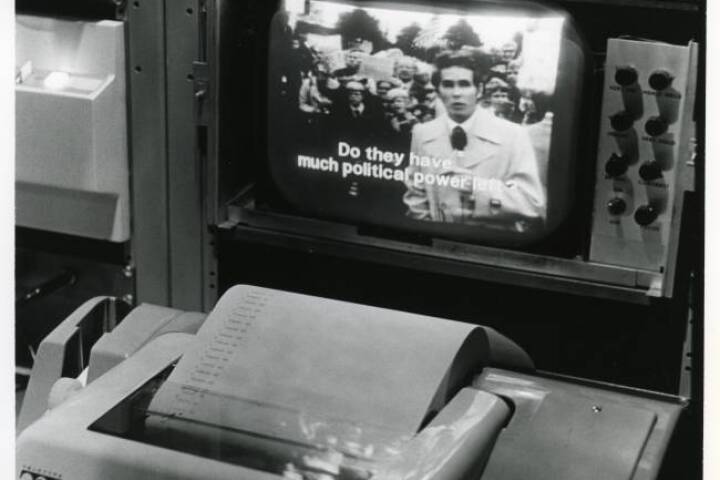Text by Daphne Northrop
Photo editing by Meredith Nierman
Edited and described by Ellen London, with assistance from
NCAM
July 22, 2020
Since the founding of WGBH, we have been dedicated to making media accessible to everyone. As we commemorate the 30th anniversary of the Americans with Disabilities Act, we invite you to take a look back at the evolution of creating media that can be used, read and viewed by people with disabilities.

The Caption Center at WGBH invents broadcast captioning, providing open captions on TV for the first time. Closed captions, which viewers can choose to turn on or off, came along around 1980. (Photo: Courtesy of WGBH)
1971

The French Chef with Julia Child, a WGBH production, airs on PBS with open captions created at WGBH. (Photo: Courtesy of WGBH)
1972

WGBH’s Caption Center begins open-captioning ABC World News Tonight, for rebroadcast later in the evening, often providing additional news stories of special interest to people with hearing impairments as well as late-breaking news. (Photo: Courtesy of WGBH)
1973

President Richard Nixon's second inaugural speech uses open captions — an American first. (Photo: Library of Congress)
1973

WGBH’s ZOOM becomes the first children's series to be open-captioned. (Photo: Courtesy of WGBH)
1975

Sesame Street becomes the first closed-captioned children's television program. (Photo: Charles Baum. Sesame Street excerpts provided courtesy of Sesame Workshop, New York, New York. © 1981 Sesame Workshop®, Sesame Street®, and associated characters, trademarks, and design elements are owned and licensed by Sesame Workshop. All rights reserved.)
1981

Real-time closed captioning is introduced in the United States by the National Captioning Institute. (Photo: Courtesy of WGBH)
1982

In a first for America, the Caption Center provides real-time captioning of the local news programs in Boston for two hours a day. | WGBH launches the first test of audio description for people who are blind or visually impaired on PBS’s American Playhouse. (Photo: Courtesy of WGBH)
1986

Americans with Disabilities Act (ADA) passes on July 26. | WGBH wins a special Emmy from The National Academy of Television Arts and Sciences for bringing audio description to television. (Photo: Barry Thumma/AP Photo)
1990

WGBH’s accessibility center, now known as The Carl and Ruth J. Shapiro Family National Center for Accessible Media (NCAM), was formed at WGBH as the research arm of the Media Access Group. (Photo: Courtesy of WGBH)
1991

President Clinton's Inauguration is the first live event to have both captioning and audio description on PBS. (Photo: Library of Congress)
1993

The Caption Center introduces relocatable roll-up captioning during the Winter Olympic Games for CBS, which ensures that important action or graphics are not obscured by captions.
1994

MoPix’s movie theater captioning technology, Rear Window, premiers in 10 theaters across the country showing films captioned by WGBH’s Caption Center. MoPix displays captions on a small LED screen installed at individual theater seats. WGBH had received a US Patent for this technology in 1996, one of two patents held by WGBH in the area of accessibility. (Photo: Courtesy of WGBH)
1999

WGBH develops MAGpie, the world's first do-it-yourself captioning application to be made available on the internet. (Photo: Courtesy of WGBH)
2000
2005
WGBH coordinates the description track of Stevie Wonder's "So What the Fuss," voiced by Busta Rhymes — the first-ever described music video.

NCAM publishes Effective Practices for Description of Science Content, which remains the standard for creating meaningful image descriptions for educational publishing and online materials. (Photo: Courtesy of WGBH)
2008

Twenty-First Century Communications and Video Accessibility Act of 2010 is passed, requiring closed captioning on streaming video and audio descriptions. The bill was sponsored by Massachusetts Senator Ed Markey (then-Congressman), and NCAM leadership played a key role in this landmark legislation, co-chairing the Federal Communications Commission (FCC) committee that developed the law’s requirements. (Photo: Courtesy of WGBH)
2010

NCAM wins the FCC Chairman's Award for Advancements in Accessibility for Media Access Mobile (MAM), which provides captions and audio descriptions to users in large public spaces via personal devices. (Photo: Courtesy of WGBH)
2012

WGBH receives its second US patent for accessibility (shared with Nuance communications), for work related to accurately measuring the accuracy and quality of television captions.
2015
2016
Replacing MAGpie (2000), WGBH develops CADET, a free browser-based tool for adding captions and audio descriptions to online video and audio. | NCAM shares a Technical Emmy for creating a standard for delivering closed captions on the internet.

Eclipse Soundscapes app launches to provide an accessible smartphone app to make the “Great American Eclipse” of August 21, 2017 accessible to all. Using specialized imagery description techniques developed by NCAM, it includes a haptic, audio, and visual tour of high-resolution photographs of various stages of a full eclipse. (Photo: Meredith Nierman/WGBH)
2017

WGBH wins the FCC Chairman’s Award for Advancements in Accessibility for the CADET captioning tool. (Photo: Courtesy of WGBH)
2018

For achievement in audio description, NCAM wins the Barry Levine Memorial Career Achievement Award from the Audio Description Project of the American Council of the Blind. (Photo: Courtesy of WGBH)
2018
Contact NCAM
Mailing Address:
Carl and Ruth Shapiro Family National Center for Accessible Media at GBH (NCAM)
One Guest Street
Boston, MA 02135
Phone:
617-300-3400
For more updates from NCAM and around the accessibility industry, follow us on social media: